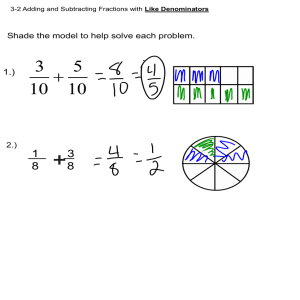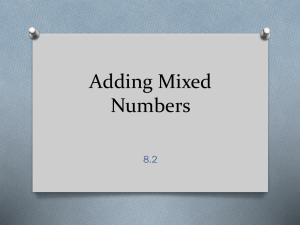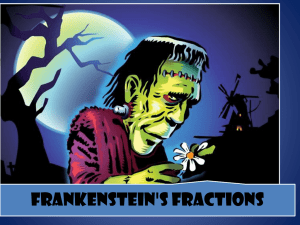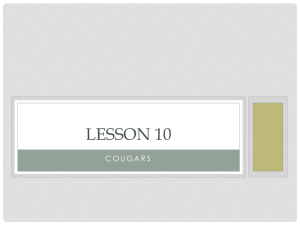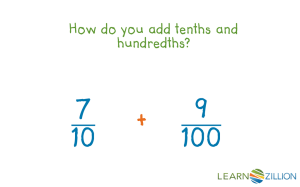real_lifefractions - Etiwanda E
advertisement
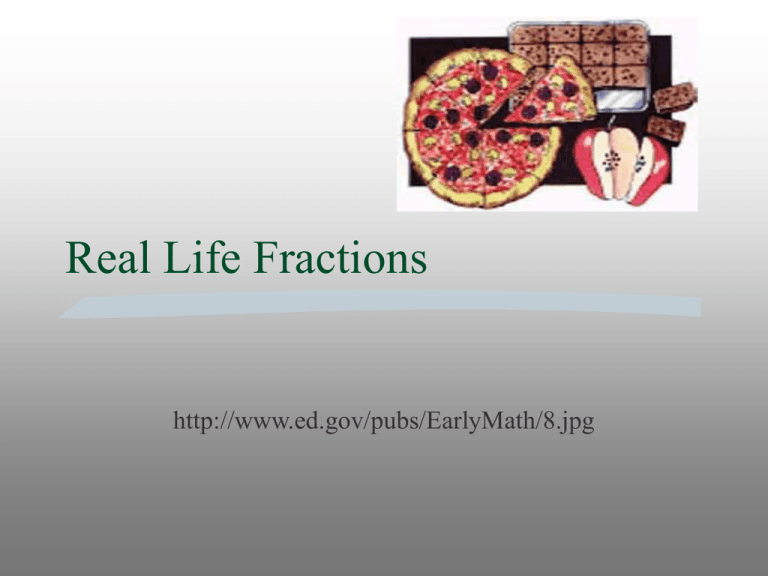
Real Life Fractions http://www.ed.gov/pubs/EarlyMath/8.jpg When do we use fractions? Cooking Measurement Telling time Money What is a fraction? Fractions show part of something. Such as pieces of a pizza, part of an hour, half a pound, a quarter of an dollar. The top of the fraction is the numerator. It tells the pieces. The bottom of the fraction is the denominator. It tells how many make up a whole. What the fraction looks like. Numerator 1 Part Denominator 2 Whole/All parts Equivalent Fractions Sometimes we can write a fraction more than one way. If we have 4 out of 6 slices of cake left we can write our fraction two ways, because 4/6 = 2/3. 4/6 is shaded and also 2/3 is shaded. http://www.mathleague.com/help/fractions/fractions.htm#whatisafraction Equivalent Fractions Look to see if the numerator and denominator have a like factor. If they do, we can simplify the fraction. Examples: 3 and 9 have like factors, so 3/9 = 1/3. Adding Fractions When we combine units the denominators need to bee the same. Meaning, when we add fractions, we have to have like denominators. 2 +3=5 3 +6 = 9 7 7 7 11 11 11 Common Denominators If you are not given like denominators, you have to find the least common denominator. Take your denominators, and factor them out. Then, match up any common denominators. Pull one factor for each match. For example 2x2=4 and 2x3=6, so pull out one 2 since there is a 2 in each. Common Denominators Next, account for the numbers not matched up. So for 4 and 6, we would account for the 2 and 3 that did not match up. We would multiply all the numbers together. Meaning the 2 and 3, with the number we took out earlier, which was a 2. So from 2 x 2 =4 and 2 x 3 = 6, our denominator would be 2x2x3=12. Find the common denominator when given these two fractions. 1+2 = ? 3 9 ? Remember your denominators are 3 and 9. If you put 9 you are right! 3 x 1 = 3 and 3 x 3= 9 One 3 matches up, so take it out. The rest does not, so take the remaining 3 and 1 out. 3x3x1=9 How to change into equivalent fractions. Once you have found your common denominator, you need to find the equivalent fractions. 1 = 3 Because we need 9 as our denominator, 3 9 we multiply 3 x 3 to get 9. What ever we multiply the denominator by, we do the same to the numerator. If our denominator has to be 12, try to find the numerator. 3= ? 4 12 If you said 9 you are correct! 3= 9 4 12 Because 4 x 3 = 12, you have to multiply the top by 3 also. 3x3=9 Once you have like denominators you can add. Solve 3 + 2 9 9 = ? ? Exactly! 3 +2 =5 9 9 9 Try this one next: 2+1= 3 5 Remember you need to find like denominators. Did you get: 2 + 1 = 13 3 5 15 Why? Your denominator has to be 15, because 3 and 5 have no like factors, so multiply 3 x 5 = 15. 10 + 3= 13 15 15 15 Congratulations! You are on your way to mastering fractions. Works Cited Picture on Page 1 http://www.ed.gov/pubs/EarlyMath/8.jpg Picture on Page 5 http://www.mathleague.com/help/fractions/fractions.htm# whatisafraction All other pictures clip art.

